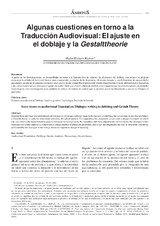Algunas cuestiones en torno a la Traducción Audiovisual: El ajuste en el doblaje y la Gestalttheorie
Some issues on audiovisual Translation: Dialogue writing in dubbing and Gestalt Theory
Autor
Richart Marset, Mabel
Editor
Asociación de Estudios de Ciencias Sociales y HumanidadesFecha
2011Materia
Traducción audiovisualDoblaje
Análisis genético
Fraseología
Teoría de la Gestalt
Audiovisual Translation
Dubbing
Genetic Analysis
Phraseology
Gestalt theory
METS:
Mostrar el registro METSPREMIS:
Mostrar el registro PREMISMetadatos
Mostrar el registro completo del ítemResumen
A partir de las investigaciones ya desarrolladas en torno a la llamada fase de «ajuste» en el proceso del doblaje, este ensayo se propone demostrar la utilidad de la Gestalttheorie para comprender y estudiar dicho fenómeno. Al mismo tiempo, y con la finalidad de apoyar dicho argumento, aporta un documento exclusivo en el que se puede comprobar el proceso de transformación entre el texto del traductor o traductora y las correcciones introducidas por el agente ajustador. Dado que el texto objeto de análisis está compuesto por un elevado número de unidades fraseológicas, esta investigación pone también de relieve el cambio de sentido que se produce por el moldeamiento a que se ve obligado el ajustador. Starting from previous research already developed on «dialogue writing» stage in the process of dubbing, this essay aims to test the usefulness of Gestalt theory in order to understand and study this phenomenon. For supporting this argument, we provide a unique document in which one can observe the transformation process between the text given by the translator and those adjustments carried out by the dialogue writer. Since the text under analysis is composed of a large number of phraseological units, this essay also highlights the way in which the «molding» performed by the dialogue writer brings about an important change of meaning.

